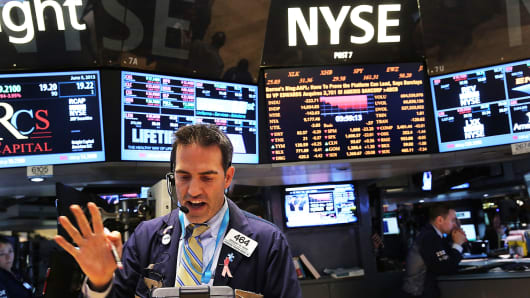Selling picked up speed in afternoon trading after the S&P 500 fell through 1600, then 1598, the bottom of a support range, and a move that puts the next downside target closer to 1575, traders said. The S&P closed at 1588, down 40 points, or 2.5 percent, while the Dow tumbled 353 points, or 2.3 percent to 14,758, wiping out its May and June gains.
"It's freaking, crazy now," said one stock trader during the 3 p.m. ET hour as the Dow sunk more than 350 points. "Even defensive sectors are getting smoked. The super broad-based sell off between commodities, bonds, equities - I wouldn't say it's panic, but we've seen aggressive selling on the lows." The CBOE's Volatility index, the VIX, bounced 26 percent and was above 20 for the first time this year.
Some emerging markets were much harder hit, like Brazil, down almost 4 percent to a four-year low before recovering. Turkey was down 5 percent. Emerging market currencies were also slammed from India, to South Africa and Mexico. Weak manufacturing data from China overnight helped fuel selling in commodities and materials.
(Read More: Global Markets Feel the Sting of Fed's Tapering)
The 10-year Treasury yield rose as high as 2.47 percent, above a range it has been trapped in since August 2011. Yields were at about 2.4 percent in afternoon trading, but a close above that would be key to some technicians and could mean rates continue to move higher.
"I do think this is the beginning of a long-term trend in rising rates," said Ward McCarthy, Jefferies chief financial economist. "But I don't think this is the beginning of a longer-term trend of a decline in stocks. I think stocks will stabilize. Eventually, you're going to start to see a rotation out of fixed income into stocks, and stocks will rise."
Already, investors have been dumping bonds, since yields began moving higher in early May. ICI said there were more than $13 billion in outflows from bond funds last week alone.
"What we've seen now, and my concern is what we've seen now and my concern today is this negative feedback loop between mortgages and investment grade credit and Treasurys," said John Briggs, senior Treasury strategist at RBS. He said some of the selling in Treasurys came as traders hedged against a volatile mortgage market, which saw spreads initially widen, then narrow, then even widen again.
"My guess is this calms down … and then the importance of the economic data releases will become quite profound. As we sit today, I think the Fed's probably going to continue $85 billion per month through October and in October decide, they'll start the wind down in November," said McCarthy. Markets shrugged off improved data from the Philadelphia Fed and better home sales Thursday.
(Read More: Jobless Claims Rise as Factory Growth Slows)





